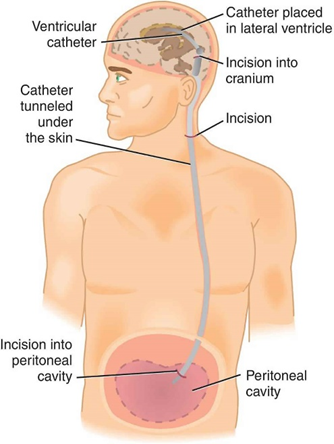A nurse is caring for a child who is postoperative following the insertion of a ventriculoperitoneal shunt. The nurse should place the child in which of the following positions?
A 45 degree head elevation
On the nonoperative side
Prone
Supine
The Correct Answer is D
A. A 45-degree head elevation: This position can help facilitate venous drainage and reduce intracranial pressure. Elevating the head of the bed may aid in preventing the accumulation of cerebrospinal fluid (CSF) in the brain, which is important after VP shunt insertion to maintain proper drainage. However, this position alone may not be sufficient.
B. On the nonoperative side: Placing the child on the nonoperative side can help reduce pressure on the side where the shunt was inserted, minimizing discomfort and the risk of disruption or displacement of the shunt. However, this position may not directly affect CSF drainage.
C. Prone: Placing the child prone (lying face down) is generally not recommended after VP shunt insertion. This position may increase pressure on the head and interfere with proper CSF drainage, potentially leading to complications.
D. Supine: Placing the child supine (lying on their back) is typically recommended after VP shunt insertion. This position helps promote proper drainage of CSF through the shunt system without placing undue pressure on the surgical site. It also allows for easy monitoring of the child's condition and surgical site.

Nursing Test Bank
Naxlex Comprehensive Predictor Exams
Related Questions
Correct Answer is ["B","C"]
Explanation
A. "You should begin to manipulate the infant's bedtime based on the hospital's visiting hours."
This statement is incorrect. Manipulating the infant's bedtime based on hospital visiting hours may disrupt the infant's regular sleep schedule, potentially causing discomfort and distress. It's important to maintain the infant's routine as much as possible to promote comfort and well-being.
B. "You should bring the infant's favorite blanket to the hospital."
This statement is correct. Bringing the infant's favorite blanket or comfort item can provide familiarity and comfort during the hospital stay. Having familiar items from home can help soothe the infant and reduce anxiety associated with the new environment.
C. "You should read the child a story about hospitalization."
This statement is correct. Reading a story about hospitalization to the child can help prepare them for the upcoming experience and alleviate fear or anxiety. Choosing age-appropriate books that explain what to expect during a hospital stay can help normalize the experience and provide reassurance to the infant and parents.
D. "You will need to go home when it is not visiting hours."
This statement is incorrect. Parents are typically allowed to stay with their infant throughout the hospitalization, especially in the case of pediatric patients. Family presence is important for providing comfort and support to the infant and facilitating bonding during the hospital stay.
Correct Answer is C
Explanation
A. Overriding aorta: In Tetralogy of Fallot, the aorta is positioned over the ventricular septal defect (VSD), rather than solely over the left ventricle as it would be in a normal heart. This is called overriding aorta, which allows blood from both the right and left ventricles to enter the aorta.
B. Pulmonary stenosis: This is a critical component of Tetralogy of Fallot. Pulmonary stenosis refers to narrowing of the pulmonary valve or the area just below it, which restricts blood flow from the right ventricle to the pulmonary artery. This results in decreased blood flow to the lungs for oxygenation.
C. Left ventricular hypertrophy: This choice is not typically associated with Tetralogy of Fallot. Left ventricular hypertrophy refers to an enlargement or thickening of the muscular wall of the left ventricle of the heart. It is often seen in conditions where the left ventricle has to work harder to pump blood, such as in hypertension or aortic stenosis, but it is not a characteristic feature of Tetralogy of Fallot.
D. Ventricular septal defect: This defect is one of the four components of Tetralogy of Fallot. A ventricular septal defect (VSD) is a hole in the septum, the muscular wall that separates the left and right ventricles of the heart. In Tetralogy of Fallot, the VSD allows oxygen-poor blood from the right ventricle to flow directly into the left ventricle and out to the body.

Whether you are a student looking to ace your exams or a practicing nurse seeking to enhance your expertise , our nursing education contents will empower you with the confidence and competence to make a difference in the lives of patients and become a respected leader in the healthcare field.
Visit Naxlex, invest in your future and unlock endless possibilities with our unparalleled nursing education contents today
Report Wrong Answer on the Current Question
Do you disagree with the answer? If yes, what is your expected answer? Explain.
Kindly be descriptive with the issue you are facing.
